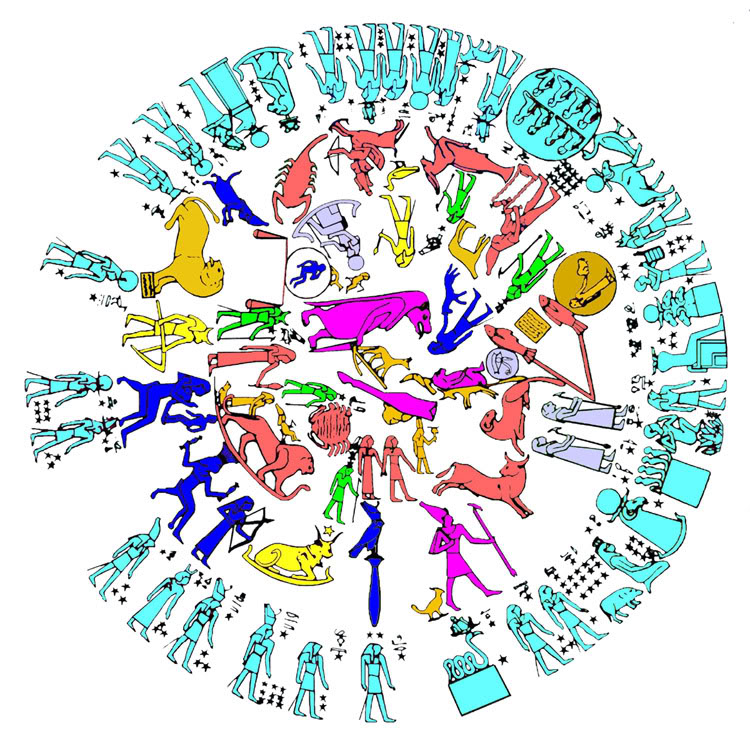Types of Signs in Astrology
As seen from the earth, the Sun will pass through a narrow band of constellations in the sky over the course of a 365 day year. If you divide that circle into 12 equal parts, each comprising 30 degrees of a 360 degree circle, each of those equal parts will be called a sign and will be related to a story from myth and legend, a certain type of energy, and a time of the year. These are the twelve signs of the zodiac. The word zodiac means “a circle of animals” is related to the word “zoo.”
The Sun, Moon and planets will pass through these signs at different speeds over the course of time and their unique energies are expressed differently in different signs.
In astrology twelve signs are divided up into two main categories:
- Element, also called quadruplicity, and
- Modality, also called triplicity
Element (Quadruplicity)
Signs come under the classification of their element, a kind of symbolic naturalistic way of describing their type of energy.
- Fire signs are noted for their tendency towards excitement, spirituality, and intensity. They are quick to act and are very charismatic.
- Air signs are noted for their intellectual propensities, communicativeness, and detachment. They serve many times to bring people and situations together, bridging differences.
- Water signs are noted for their emotional richness, connectedness, and sensitivity. There is a strong reflective, creative and empathic nature to them.
- Earth signs are noted for their practicality, sensuality, and dependability. Earth signs can be slow to react or move, but they excel in acting for the long run.
All of the signs of the same element are at trines to each other; i.e. Aries is trine to Leo, and so forth.
Modality (Triplicity)
The modality of a sign refers to its methods of action.
- Cardinal signs tend to be direct, forceful, and immediate in their actions.
- Fixed signs tend to be constant, deep, and determined.
- Mutable signs tend to be adaptable, flexible and diplomatic in their actions.
All of the signs of the same modality are at squares to each other; i.e. Aries is square to Cancer, and so forth.
| Sign | Modality | Element |
| Aries | Cardinal | Fire |
| Taurus | Fixed | Earth |
| Gemini | Mutable | Air |
| Cancer | Cardinal | Water |
| Leo | Fixed | Fire |
| Virgo | Mutable | Earth |
| Libra | Cardinal | Air |
| Scorpio | Fixed | Water |
| Sagittarius | Mutable | Fire |
| Capricorn | Cardinal | Earth |
| Aquarius | Fixed | Air |
| Pisces | Mutable | Water |
Astrological Rulership
Each sign has a planetary ruler, a planet that is similar in expression and is said to “rule”, or be strongly connected to that sign and house where the planet is in. Therefore the condition of a sign’s ruler in a chart will have a direct effect on how that sign itself expresses itself in a person’s life. Therefore, planets will have a certain dignity in different signs:
- Rulership: the planet is similar in nature to the sign, therefore it works well there.
- Debilitation: the planet is not similar in nature to the sign, therefore it typically does not work well there.
- Exaltation: the planet works exceedingly well in that sign, therefore it works exceedingly well there.
- Fall: the planet is exceedingly averse to the nature of the sign, therefore it does not work well in that sign.
Anatomical Correlation of the Signs
Astrological signs also have a human anatomical connection, having microcosmical affinities to celestial macrocosmic things.
Myth and Symbolism of the Signs
Each sign has a myth, symbol or legend attached to it, mainly by the constellations they are connected with. These stories represent universal myths and legends, which have strong archetypal meaning and significance in our lives.

"Zodiac" is related to "zoo", or a circle of animals















